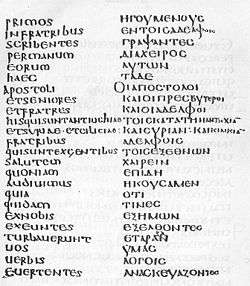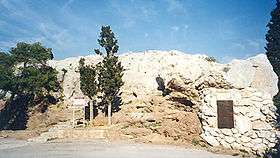Acts 17
| Acts 17 | |
|---|---|
 Acts 15:22-24 in Latin (left column) and Greek (right column) in Codex Laudianus, written about AD 550. | |
| Book | Acts of the Apostles |
| Bible part | New Testament |
| Order in the Bible part | 5 |
| Category | Church history |
Acts 17 is the seventeenth chapter of the Acts of the Apostles in the New Testament of the Christian Bible. It records the second missionary journey of Paul, together with Silas and Timothy.[1] The book containing this chapter is anonymous but early Christian tradition uniformly affirmed that Luke composed this book as well as the Gospel of Luke.[2]
Text
- The original text is written in Koine Greek and is divided into 34 verses. Some most ancient manuscripts containing this chapter are:
- Codex Vaticanus (AD 325-350)
- Codex Sinaiticus (AD 330-360)
- Codex Bezae (c. AD 400)
- Codex Alexandrinus (c. AD 400-440)
- Papyrus 127 (5th century; extant: verses 1-10)
- Codex Laudianus (c. AD 550)
Location
This chapter mentions the following places (in order of appearance):
Timeline
The second missionary journey of Paul took place in c. AD 49.[3]
Structure
This chapter can be grouped:
- Acts 17:1-4 = Preaching Christ at Thessalonica
- Acts 17:5-9 = Assault on Jason’s House
- Acts 17:10-15 = Ministering at Berea
- Acts 17:16-21 = The Philosophers at Athens
- Acts 17:22-34 = Addressing the Areopagus
Distances
The apostles traveled from Philippi to Thessalonica, a distance of 161 km (on modern roads), and from Thessalonica to Berea (modern Veria), which is 72 km. Paul then travelled to 'the sea', which would have been at least 42 km to the nearest point, and then south to Athens, approximately 300 km (by sea). The journey 'by night' from Thessalonica to Berea (Acts 17:10) presumably took more than one night.
The 'Babbler' (Verse 18)
- Then certain Epicurean and Stoic philosophers encountered him. And some said, “What does this babbler (Greek: σπερμολογος, literally seed-picker) want to say?”
- Others said, “He seems to be a proclaimer of foreign gods,” because he preached to them Jesus and the resurrection.[4]
Addressing the Areopagus
.jpg)
The speech, known as the Areopagus sermon, refers to a sermon or explanation delivered by Apostle Paul at the Areopagus in Athens, and described in Acts 17:16-34.[5][6] The Areopagus sermon is the most dramatic and fullest reported speech of the missionary career of Saint Paul and followed a shorter address in Lystra Acts 14:15-17.[7] Paul explained concepts such as the resurrection of the dead and salvation, in effect a prelude to the future discussions of Christology. According to the record, after the sermon, a number of people became followers of Paul. These included a woman named Damaris, and Dionysius, a member of the Areopagus. This latter has at times been suggested as Dionysius the Areopagite, but that may be a historical confusion.[8]
See also
References
- ↑ Halley, Henry H. Halley's Bible Handbook: an abbreviated Bible commentary. 23rd edition. Zondervan Publishing House. 1962.
- ↑ Holman Illustrated Bible Handbook. Holman Bible Publishers, Nashville, Tennessee. 2012.
- ↑ John Arthur Thomas Robinson (1919-1983). "Redating the New Testament". Westminster Press, 1976. 369 pages. ISBN 978-1-57910-527-3
- ↑ Acts 17:18
- ↑ Christianity: an introduction by Alister E. McGrath pages 137-141, 2006, ISBN 1-4051-0901-7
- ↑ Theology of the New Testament by Udo Schnelle (Nov 1, 2009) ISBN 0801036046 page 477
- ↑ Mercer Commentary on the New Testament by Watson E. Mills 2003 ISBN 0-86554-864-1 pages 1109-1110
- ↑ Paul: A Brief History by Robert Paul Seesengood 2010 ISBN 1-4051-7890-6 page 120
